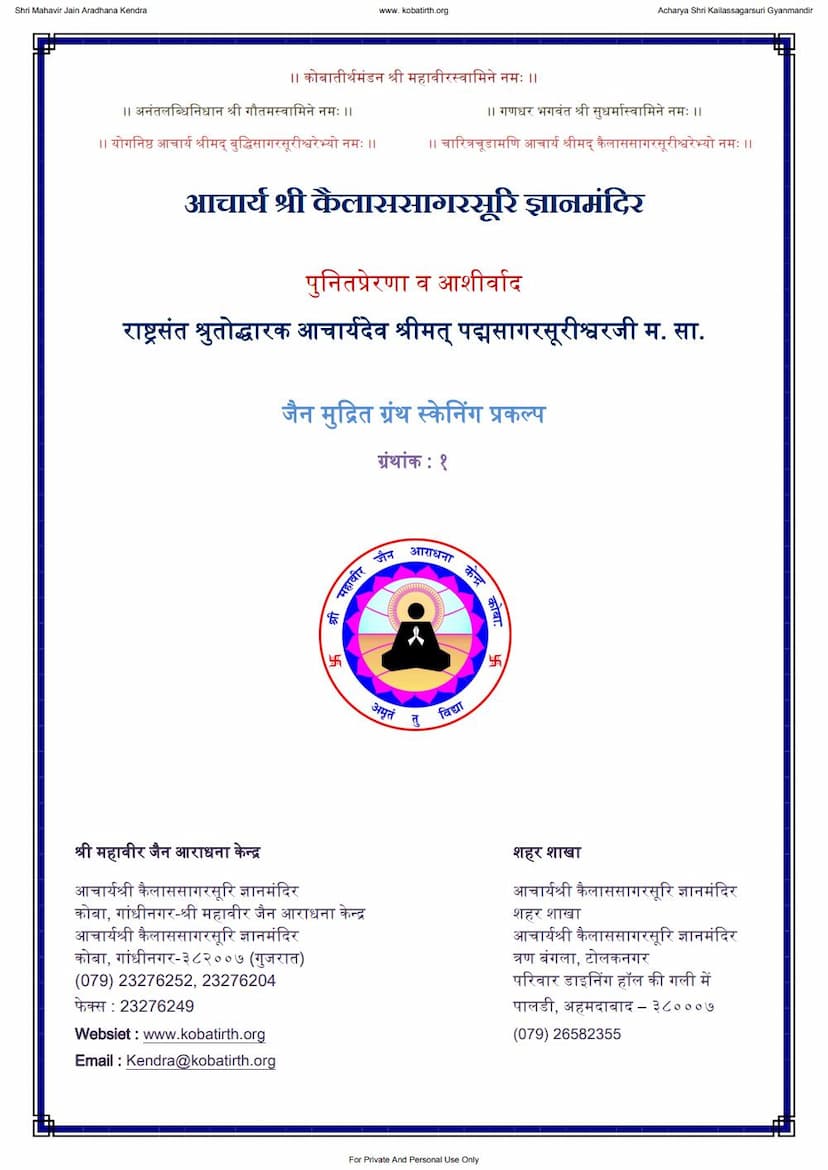Agam 28 Prakirnaka 05 Tandul Vaicharik Sutra Shwetambar
Added to library: September 1, 2025

Summary
This document is a digital reproduction of the Jain text "Tandul Vaicharik Sutra," part of the Agam literature, specifically within the Prakirnaka category (Agam 28, Prakirnaka 05). It is a Shwetambar Jain text, edited and revised by Acharya Shri Anandasagarsurishwarji Maharaj and compiled by Muni Shri Poornachandrasagarji Maharaj. The publisher is Jainanand Pustakalay, Surat.
The document begins with acknowledgments and dedications to various esteemed Jain Acharyas and saints, highlighting their contributions to the preservation and dissemination of Jain scriptures. It emphasizes the importance of Shrut (scriptural) knowledge and the Agamas as the teachings of Lord Mahavir Swami.
A significant portion of the initial pages (6-10) provides a historical overview of the compilation and recitations (Vachanas) of the Jain Agamas. It details:
- The formation of the Agamas: Attributed to the first Ganadhara, Shri Indrabhuti Gautam Swami, and other Ganadharas immediately after Lord Mahavir's nirvana.
- The transmission of knowledge: Initially through oral tradition (mouth-to-mouth memorization) rather than written texts.
- The six major Agam Vachanas:
- First Vachana: Held in Pataliputra (Patna) around Vir Nirvan Samvat (VNS) 160, under the presidency of Shri Sthulabhadra Swami, to address the disruption caused by a severe famine and the scattering of monks.
- Second Vachana: Conducted in Ujjain between VNS 245-281, initiated by King Samprati and guided by Acharya Shri Aryasuhasti Suri, aimed at preserving the Agamas.
- Third Vachana: Took place around VNS 300-330, involving a large assembly of monks and nuns, to organize the texts of eleven Angas and ten Purvas, after a period of persecution by King Pushyamitra.
- Fourth Vachana: Held in Dashpur (Mandsaur) around VNS 592 by Acharya Shri Aryarakshit Suri, who organized the four Anuyogas to make the Agamas accessible for future generations with diminished memory capacity.
- Fifth Vachana: Occurred around VNS 830-840 in Mathura (North India) and Valabhi (South India), organized by Acharya Shri Skandil Suri and Acharya Shri Nagarjun Suri respectively, due to the prevailing confusion.
- Sixth Vachana: The final major compilation, held in Valabhi (Saurashtra) by Acharya Shri Devardhigani Kshamashraman and Acharya Shri Kalak Suri, where the 84 Agamas were systematically arranged and inscribed on palm leaves, marking the transition to written scriptures. This period is considered to have maintained the Agamic tradition for about 1000 years after Lord Mahavir.
The text then laments the decline in scriptural knowledge after these compilations, particularly after the 10th century CE, due to the influence of Kalikala (the age of moral decline) and the rise of laxity (Shithilachar). It notes that the pure lineage of scholars became rare, and Agamic texts became difficult to obtain.
The document highlights the efforts of Acharya Shri Anandasagar Surishwarji Maharaj in the 20th century, who is praised for reviving the study of Agamas by meticulously researching and reprinting these ancient texts. He organized community recitations (Samuhik Vachanas) in various locations, re-establishing the tradition of studying the Agamas for hundreds of monks and nuns.
The "Tandul Vaicharik Sutra" itself (starting from Page 12) appears to be a detailed discourse on:
- The life cycle of a human being: It describes the stages from conception to old age, detailing the development of the fetus within the womb, the formation of the body's components, and the physical and mental changes that occur throughout life.
- The human body: It provides an extensive and detailed anatomical description, including bones, muscles, organs, veins, nerves, and orifices, often emphasizing the impure and perishable nature of the physical body.
- Diet and sustenance: It discusses the concept of food intake, breath (Uchchvas-Nichchvas), and the calculation of lifespan and food consumption.
- The process of conception and birth: It describes how the soul enters the womb and the stages of fetal development.
- The consequences of actions: It touches upon how actions (karma) can lead to rebirths in hellish realms or celestial abodes.
- The ephemeral nature of life: It repeatedly emphasizes the impermanence of youth, beauty, wealth, and life itself, urging the reader to focus on Dharma (righteousness).
- The illusory nature of worldly attachments: It critiques attachment to the body, sensory pleasures, and relationships, highlighting their transient and ultimately sorrowful nature.
- The importance of Dharma and good conduct: It strongly advocates for the practice of Dharma, virtuous deeds, and the pursuit of spiritual liberation (Moksha) as the ultimate goals, contrasting them with the futility of worldly pursuits.
- Descriptions of the human body: The text contains very graphic and detailed descriptions of the human body, its internal workings, and its eventual decay and decomposition, aiming to instill detachment and aversion to the material form.
- The nature of women: There are extensive and rather critical descriptions of women, portraying them as alluring but ultimately deceptive and a source of attachment and downfall for men. This section is quite lengthy and reiterates the idea that women are a major impediment to spiritual progress.
- The ephemeral qualities of life and relationships: It likens youth, love, and life to fleeting phenomena like flowers, dew, rivers, and waves, emphasizing their impermanence.
In essence, the "Tandul Vaicharik Sutra" is a didactic text that uses detailed descriptions of the physical body and the life cycle to cultivate a sense of detachment (vairagya) and inspire the reader to pursue spiritual liberation through Dharma. It serves as a stark reminder of the transient and impure nature of existence, urging the renunciation of worldly desires and the steadfast adherence to Jain principles.